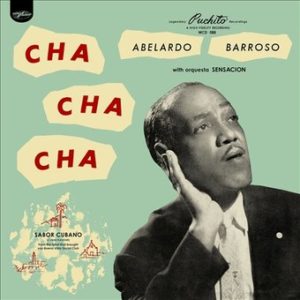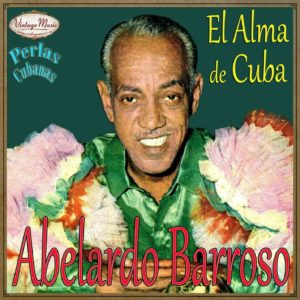ABELARDO BARROSO: EL PRIMER “SONERO MAYOR” DE CUBA. UNO DE LOS PRECURSORES DE LA MÚSICA SALSA. PHOTOS/VIDEOS.
Hace unos meses recibí un ejemplar disco de Abelardo Barroso “Cha Cha Cha”. Este disco me abrió los ojos y los oídos a la música de uno de los precursores de nuestra música Salsa.
“Cha Cha Cha” captura a Abelardo Barroso quizás en la mejor de las 3 épocas principales que tuvo durante su carrera. Estos incluyeron la era con la Orquesta Sensación principalmente durante la década de 1950. Barroso y Orquesta Sensación se convirtieron en un gran éxito y la tercera llegada de Barroso a la escena de la música popular. Este álbum recoge algunos de los mejores éxitos de Abelardo Barroso. Algunas de estas canciones deberían sonar familiares para los amantes de la música Salsa. Los éxitos clásicos incluyen “Bruca Manigua”, “Yo ‘Ta Cansa”, “Guantanamera”, “Suavecito” y el famoso “El Manisero”.
 VIDEOS- Abelardo Barroso en “Macorina”..
VIDEOS- Abelardo Barroso en “Macorina”..
LA CARRERA DE BARROSO COMO “SONERO”
Nacido en La Habana en 1905, Barroso inició su carrera musical en 1925 con el Sexteto Habanero de una manera peculiar. Mientras trabajaba como taxista, llevaba a integrantes del famoso ‘Sexteto Habanero’ a una discoteca. En el camino, los músicos cantaban alegremente, y Barroso se unió al canto mientras conducía. El director musical, que se encontraba entre los pasajeros, quedó tan impresionado que lo contrató en el acto.
Permítaseme señalar que en la década del 20 el Sexteto Habanero fue una de las agrupaciones más populares de música sonera en Cuba. Esto equivalía a entrar a ‘El Gran Combo’ a finales de los 60.
De ahí pasó a formar parte de otra institución musical al incorporarse dos años después al Septeto Nacional de Ignacio Piñeiro. Al grupo de Piñeiro también se le atribuye la popularización del “son”. Su éxito “Echale Salsita” fue la primera referencia conocida del término “Salsa” utilizado en referencia a la música afrocubana. “Suavecito” fue una de las canciones más populares de Ignacio Piñeiro. En este disco se incluye la regrabación de Barroso con la Orquesta Sensación. Lo que pasa con esta versión es que sabes que Barroso fue quien la popularizó directamente de la pluma del legendario autor allá por los años 20.
A finales de la década de 1920, Barroso se fue de gira por España. Fue uno de los primeros artistas cubanos en hacerlo. Cuando regresó, encontró que el “Danzante” era la nueva forma de música popular. Así que el “Caruso del Son” como se le conocía, adoptó también el “Danzonete”. Inició así la segunda venida de su carrera en Cuba.
 VIDEOS- Abelardo Barroso en “El Guajiro de Cunagua”..
VIDEOS- Abelardo Barroso en “El Guajiro de Cunagua”..
A medida que la industria discográfica comenzó a despegar en Cuba durante estos años, también lo hizo la popularidad de Barroso. Sin embargo, continuó cambiando de grupo durante los años 30. En uno de esos giros formó banda con Orestes “Macho” López (padre de Orlando “Cachaito” López) y formar la charanga López-Barroso.
Durante los años 30 las influencias de las bandas de Jazz, Charleston y el swing en los Estados Unidos influyeron en la música cubana, inspirando la creación del “conjunto”. Cuando llegó la década de 1940, artistas como Arsenio Rodríguez comenzaron a transformar el formato de conjunto, agregando trompetas, piano y una conga. A Barroso le costó adaptarse a los nuevos formatos de la época, y se quedó con el viejo son y el danzonete. A fines de la década, Abelardo Barroso había sido casi olvidado, siendo recordado como cantor de la Vieja Guardia.
Benny Moré, quien había regresado de una exitosa estadía en México con el Trío Matamoros, ayudó económicamente a Barroso durante sus tiempos difíciles. Es entonces, a mediados de la década de 1950, con el nacimiento y popularidad del “cha-cha-cha”, que Rafael Valdés recluta a Abelardo Barroso para su Orquesta Sensación. Una vez allí, comenzaron a adaptar canciones antiguas y nuevas a su nuevo formato. Barroso fue un éxito y marcó su tercera aparición en la escena musical cubana.
ABELARDO BARROSO “EL CARUSO DEL SON”
El disco de “Cha Cha Cha” de Abelardo Barroso es una joya de la música cubana. Las canciones y su interpretación en ellas pueden mostrar claramente por qué le llamaban el “Caruso del Son”. Durante su carrera, Barroso mostró una increíble habilidad para improvisar. Durante sus años con la Orquesta Sensación, Rafael Valdés decidió traer a un joven cantante para compartir las funciones de canto con el veterano Barroso. Sus “polémicas” de improvisación (donde cada cantante improvisa versos contra su “rival”) se convirtieron en un gran atractivo. Esto se debe a que el público quería ver a grandes “soneros” haciéndolo; los viejos contra los jóvenes.
Como uno de los primeros intérpretes de “son”, y que se hizo popular a través de esta voz de alto y su talento para la improvisación, Abelardo Barroso fue verdaderamente el primer “Sonero Mayor” de la música latina.
En septiembre de 1972, mientras algunos talentosos músicos cubanos formaban la banda que llamaron Irakere, Abelardo Barroso muere en La Habana. Dejó un gran legado en la música cubana para que otros construyeran a partir de él.
ABELARDO BARROSO: CUBA’S FIRST “SONERO MAYOR”. ONE OF THE FOREFATHERS OF SALSA MUSIC
A few months ago I received a copy of Abelardo Barroso “Cha Cha Cha”. This album opened my eyes and ears to the music of one of the forefathers of our Salsa music.
“Cha Cha Cha” captures Abelardo Barroso perhaps in the best of the 3 main eras he had during his career. These included the era with the Orquesta Sensacion mostly during the 1950s. Barroso and Orquesta Sensacion became a great hit and the 3rd coming of Barroso to the popular music scene. This album captures some of the best hits of Abelardo Barroso. Some of these songs should sound familiar to Salsa music lovers. Classic hits include “Bruca Manigua”, “Yo ‘Ta Cansa”, “Guantanamera”, “Suavecito”, and the famous “El Manisero”.
BARROSO’S CAREER AS “SONERO”
Born in La Havana in 1905, Barroso began his music career in 1925 with the Sexteto Habanero in a peculiar way. While working as a taxi driver, he was taking members of the famous ‘Sexteto Habanero’ to a nightclub. On the way there, the musicians were signing happily, and Barroso join the singing while driving. The musical director, who was among the passengers, was so impressed, that he hired him on the spot.
 VIDEOS- Abelardo Barroso sings “Arrancame la Vida”..
VIDEOS- Abelardo Barroso sings “Arrancame la Vida”..
Let me state that in the 20’s the Sexteto Habanero was one of the most popular groups of “son” music in Cuba. This was the equivalent of entering ‘El Gran Combo’ in the late ’60s.
From there, he joined another musical institution when he joined the Septeto Nacional de Ignacio Piñeiro two years later. Piñeiro’s group was also attributed with popularizing the “son”. Their hit “Echale Salsita” was the first known reference of the term “Salsa” used in reference to Afro Cuban music. “Suavecito” was one of Ignacio Piñeiro’s most popular songs. Barroso’s re-recording of it with the Orquesta Sensacion is included in this album. The thing about this version is that you know Barroso was the one who popularized it straight from the legendary author’s pen back in the ’20s.
At the end of the 1920s, Barroso went to tour Spain. He was one of the first Cuban artists to do so. When he returned, he found that the “Danzonete” was the new popular form of music. So the “Caruso del Son” as he was known, adopted the “Danzonete” as well. In this way, he began the second coming of his career in Cuba.
As the recording industry began to take off in Cuba during these years, so did the popularity of Barroso. However, he continued to change groups during the ’30s. In one of those turns, he formed a band with Orestes “Macho” Lopez (father of Orlando “Cachaito” Lopez) and to form the charanga Lopez-Barroso.
During the ’30s the influences of Jazz bands, Charleston, and swing in the U.S., influenced Cuban music, inspiring the creation of the “conjunto”. As the 1940s came, artists like Arsenio Rodriguez began transforming the conjunto format, adding trumpets, piano, and a conga. Barroso had a hard time adapting to the new formats of the era, and stayed with the old “son” and “danzonete”. By the end of the decade, Abelardo Barroso had been almost forgotten, being remembered as a singer of the “Vieja Guardia”.
Benny Moré, who had returned from a successful stay in Mexico with the Trio Matamoros, assisted Barroso financially during his hard times. It was then, in the mid-1950s, with the birth and popularity of the “cha-cha-cha”, that Rafael Valdes recruits Abelardo Barroso for his Orquesta Sensacion. Once there, they began adapting new and old songs to his new format. Barroso was a hit, and this marked his third coming in the Cuban music scene.
ABELARDO BARROSO “EL CARUSO DEL SON”
The album of “Cha Cha Cha” of Abelardo Barroso is a gem of Cuban music. The songs and his performance on them can clearly show why he was called the “Caruso del Son”. During his career, Barroso showed an incredible ability to improvise. During his years with Orquesta Sensacion, Rafael Valdes decided to bring in a young singer to share singing duties with the veteran Barroso. Their improvisational “controversias” (where each singer improvises verses against his ‘rival’) became a great attraction. This is because the public wanted to see great “soneros” going at it; the old vs. the young.
As one of the first performers of “son”, and one who became popular through this alto voice and his improvisation talent, Abelardo Barroso was truly the first “Sonero Mayor” of Latin music.
In September 1972, while some talented Cuban musicians were forming the band they named Irakere, Abelardo Barroso died in Havana. He left behind a great legacy in Cuban music for others to build from it.
Agencies/ Wiki/ LatinoMusicCafe/ Hector Aviles/ AbelardoBarrosoBio./ Extractos/ Excerpts/ Internet Photos/ Arnoldo Varona/ www.TheCubanHistory.com
THE CUBAN HISTORY, HOLLYWOOD.










